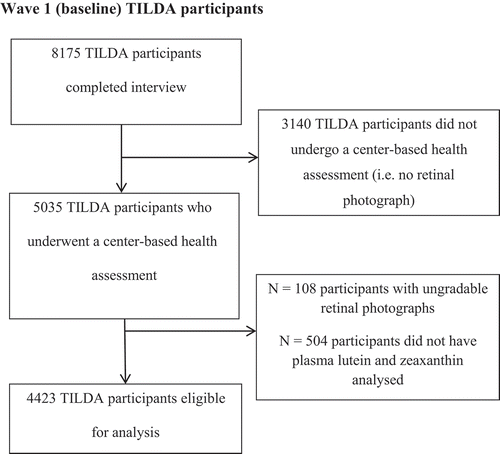Figures & data
Figure 1. The Irish Longitudinal Study on Ageing (TILDA) participants included in this investigation. Photographs were judged as ungradable based on a priori criteria of photographic quality. The phenomenon of participants without plasma concentration of lutein and zeaxanthin was attributable to one of the following: participant did not consent to give a blood sample, a failure to perform a venepuncture at the time of the health assessment, insufficient sample for carotenoid analysis or sample lost during carotenoid extraction/analysis.

Table 1. Demographics, health and lifestyle characteristics of participants in this investigation.
Figure 2. Mean plasma concentrations of lutein and total zeaxanthin of subgroups in this investigation. Plasma lutein and zeaxanthin concentrations measured by high performance liquid chromatography. Group 1 (n = 24): grading-confirmed AMD in association with self-reported AMD; Group 2 (n = 264): grading-confirmed AMD in the absence of self-reported AMD; Group 3 (n = 41): grading-confirmed absence of AMD in association with self-reported AMD; Group 4 (n = 4094): grading-confirmed absence of AMD in association with self-reported absence of AMD. Grading-confirmed AMD, retinal photographs were graded by a certified grader using a modified version of the International Classification and Grading System for AMD; Self-reported AMD, participants were asked whether a doctor had diagnosed them with AMD.

Table 2. Summary of cross-sectional studies designed to investigate a possible relationship between age-related macular degeneration and serum concentrations of macular pigment’s constituent carotenoids.
